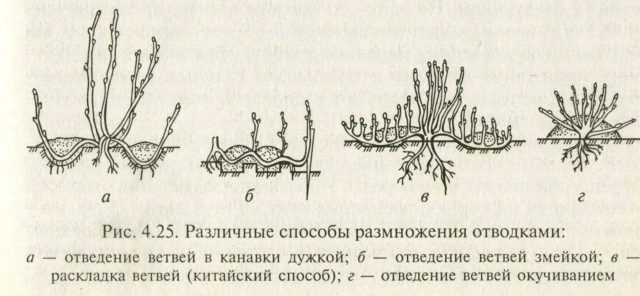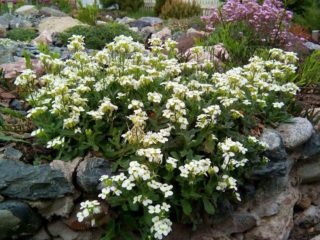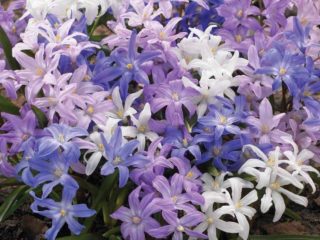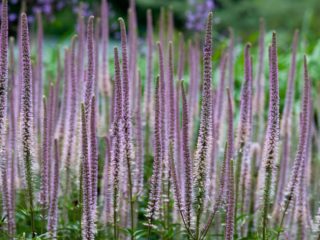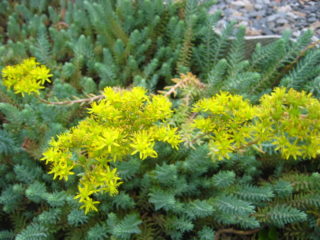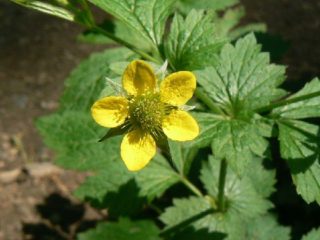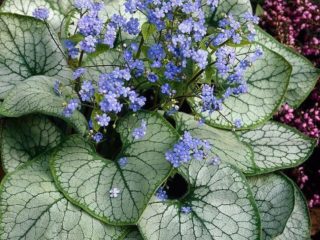Content
It is always pleasant for gardeners to deal with such a perennial as Caucasian Arabis. This is explained by the long and spectacular flowering, unpretentious care and ease of reproduction and transplantation. In addition, not only flowers, but even leaves, exquisitely sparkling with their silvery shade, have decorative properties.
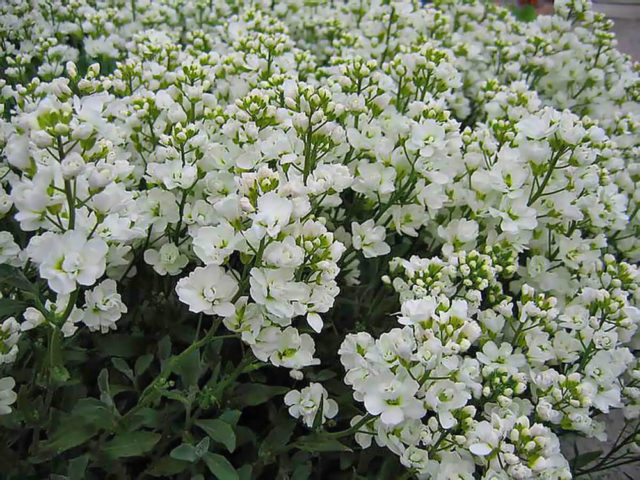
Because of the small notches on the leaves, the people call arabis "rezuha", besides this, there is another nickname that has not been confirmed by science - the sun bunny
Description of Caucasian Arabis
The name makes it clear that the birthplace of the Caucasian rezuha is the Caucasus. In addition, the culture is also found on the mountain slopes of the Crimea, Central Asia and the Mediterranean. These areas are rocky and arid. That is why the plant is not demanding on the soil and easily tolerates drought. The Caucasian Arabis (Arabis Caucasica) belongs to the cruciferous family.
Arabis Caucasian is a pillow-like plant that reaches a height of 30 cm, some subspecies are even smaller (15-20 cm). Leaves are green, with a silvery tinge, slightly pubescent. They are narrow, oblong in shape, also found with a jagged edge. Shoots are creeping, rooting.
Flowers are small, simple or double, racemose inflorescences. The range of shades is varied: the most common are white and pink arabis flowers. Also bred white with a yellow border, yellow, purple. They give off a pleasant sweet scent that bees are so attracted to. The root system is made up of many small superficial roots.
Breeders have developed several hybrid varieties, each of which enjoys popular love and wide popularity.
Plena variety
The most popular of the Caucasian rezuha varieties is Plena. This is a low-growing herb up to 25 cm high with white or pink small double flowers 1.5 cm in diameter. Captivity is abundant in flowering, occurs from May to June. It tolerates drought well, and does not tolerate stagnant water in the ground.
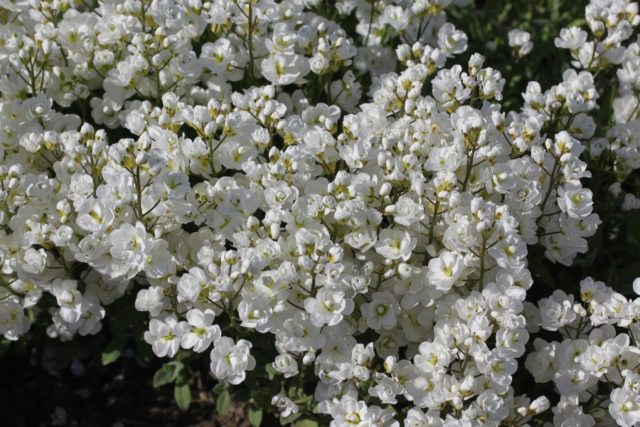
Until the plant has gained strength, it should be protected from weeds and other adverse conditions.
Little Treasure Deep Rose cultivar
Caucasian Arabis Little Treasure Deep Rose is distinguished by its dwarfism - the height is only 15 cm. The buds of a rich pink-lilac tone, bloom from the beginning of June. Budding continues for about 1.5 months. This variety loves sunny, well-ventilated areas. In partial shade, it will also be able to grow, but the flowering will not be as abundant. Caucasian Arabis Little Treasure Deep Rose is used to decorate mixborders, alpine slides and rabatoks.
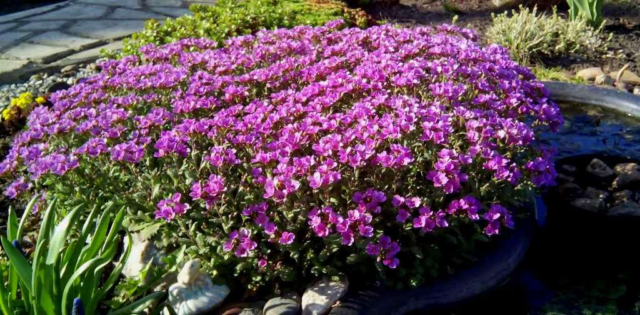
To prolong the flowering of the culture, you should remove the faded flowers.
Variety Compinka
The ground cover variety of Caucasian arabis Compinkie is characterized by powdery pink small flowers, its shoots are up to 20 cm. The bush is sprawling, abundant flowering, occurs from May to June.

Despite the large number of varieties of Caucasian arabis found in the natural environment, only 7-10 units are suitable for decorative cultivation, including Kompinki
Snowfox variety
Caucasian Arabis Snowfix instantly fills the empty space around him. Its snow-white flowers are collected in racemose inflorescences up to 8 cm long.This is one of the highest varieties among the Caucasian Arabis - it reaches 30 cm. The leaves are small, oblong and serrated, gray-green, slightly pubescent.
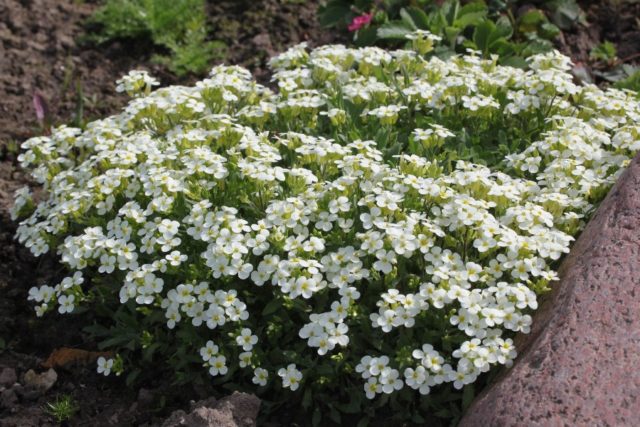
SnowFox blooms in late spring or early summer.
Application in landscape design
The main landscape advantage of the Caucasian Arabis is the ability to cover plots of land with a solid floral carpet. Thanks to this feature, rezuha is planted when decorating stone gardens, borders, flowerpots, alpine hills, rabatok, terraced slopes, filling the free space between trees or shrubs.
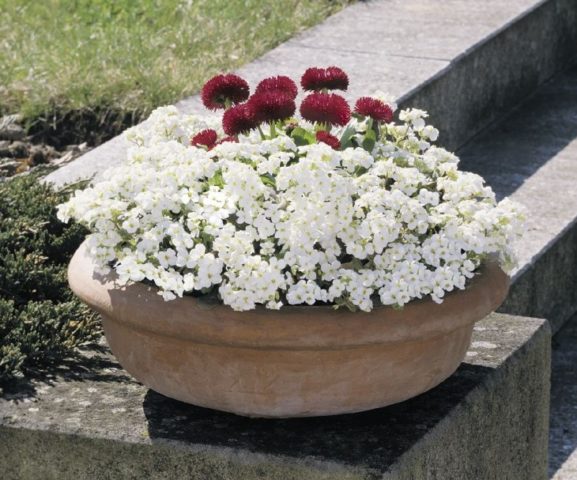
The contrast between a solid white floral wall and large red flowers will become a bright accent in the landscape composition
An interesting option is the vertical cultivation of Caucasian Arabis. Suspended compositions, as well as simply tall flower beds, in which the flower cover hangs freely, look very impressive.
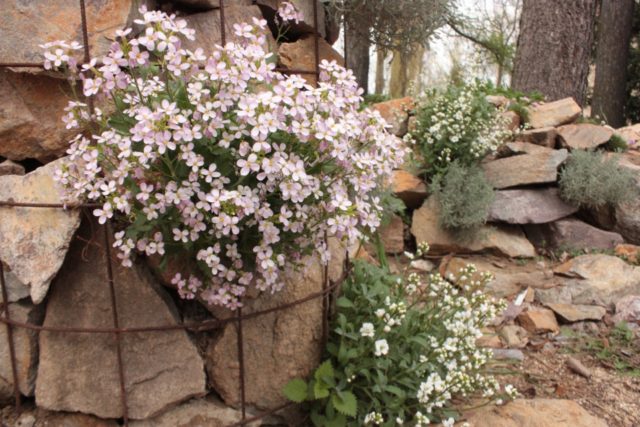
It is important to trim the plant in time, as the shoots can grow too long and pull the roots out of the ground
The example of the photo below shows a combination of Caucasian arabis of different colors:
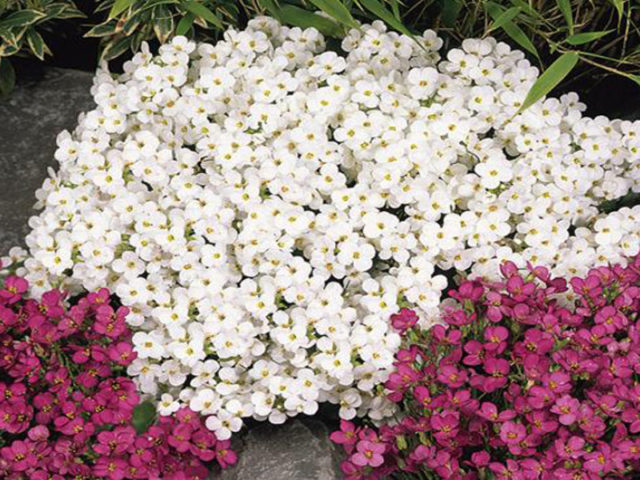
The larger the area occupied by a floral carpet made of Caucasian arabis, the more impressive the composition looks.
In addition to combining several shades of Caucasian razuha, this culture looks harmoniously with daisies, phlox, shaved, other creeping early flowering plants, as well as roses.
Breeding features
Reproduction of the Caucasian Arabis is possible in the following ways:
- Sowing seeds.
- By cuttings... A shoot up to 10 cm long is cut off, freed from the lower sheets and placed directly into the ground. Rooting takes place at about 20 days, after which the seedling should be moved to a permanent place.
- By dividing the bush... Dig a bush, divide it, plant it in different areas. It is also possible not to dig out the entire bush, but only the necessary part.Important! It should be divided into only 2-3 parts, since the seedlings may not be accepted.
- Layers... To do this, pinch the shoot from above, root it in moist soil. After 20 days, cut off the rooted shoot and transplant to the chosen place.
For the Caucasian Arabis, as the propagation options for layering, branching of branches into the grooves with a bow and the layout of branches as
Growing Caucasian Arabis from seeds
Growing from seeds of any varieties of Caucasian Arabis, be it Kompinki or Little Treasure Deep Rose, is about the same. When planning the landscape, it is important to consider that flowering occurs only the next year after planting.
Sowing terms and rules
The seeds of the Caucasian Arabis can be planted first in peat pots, or directly into the open ground. In the first case, seeds are planted from September to April. The material is deepened into containers with prepared soil and sprinkled with sand a little. Then pour over with water and place in a cool place (approximate temperature +5 ° C). In the open ground, seedlings are moved in April.
Planting seeds directly into open ground is also carried out in April. The material is placed in moistened soil to a depth of 1 cm and irrigated.
Seedling care
For faster growth, the place should be covered with plastic wrap, creating a greenhouse effect. The first shoots appear in 2-3 weeks. After the seedlings have germinated, the protective film can be removed.
Seedlings planted in peat tanks do not require stratification.
Planting and leaving
Growing and caring for the Caucasian Arabis is so simple that any novice gardener can handle them. Since the root system of the seedling is poorly developed, it should be transplanted to a permanent place with a clod of earth in which it grew.
The first time, until the plant gets stronger, it is imperative to weed the weeds and loosen the soil. If the shoots are growing too quickly, they must be shortened.
Recommended timing
After the seedlings get stronger both the root system and the foliage, they can be transplanted to a permanent place.During this time, their height will be about 15 cm. This happens at the end of May. Arabis should be transplanted on a cloudy day so that it has time to adapt to a new place.
Site selection and soil preparation
Caucasian rezuha prefers sunny areas with deep groundwater. Sandy or stony soil is favorable for abundant flowering. Clay soil is completely unsuitable, planting in a lowland. The soil should be well oxygenated and loose. The pH level is slightly acidic or neutral. If the soil is not loose enough, you can add sand, needles, fine gravel to it.
Before planting, you should well dig up the ground, removing the roots of perennial weeds from it.
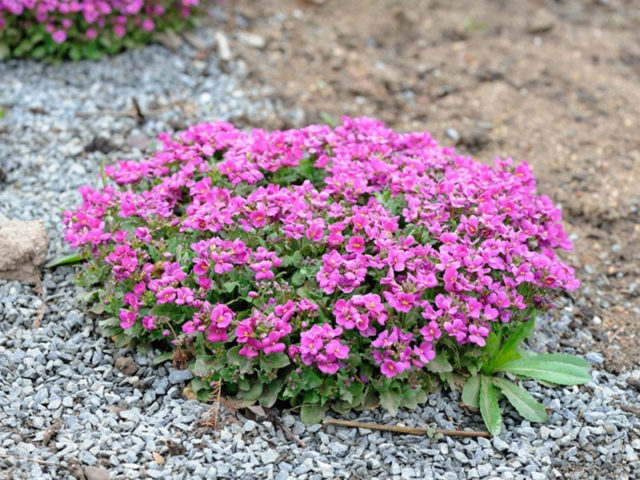
After the plant has matured, there is no need to remove weeds, since the Arabis in the garden displaces all other inhabitants
Landing algorithm
The planting of the Caucasian Arabis takes place in the following stages:
- Well preparation. If the groundwater runs too close to the surface of the earth, drainage must be laid at the bottom of the hole. It can be broken brick or expanded clay, other small stones. The distance between the holes should not exceed 30 cm.
- Lay a little soil fertilized with dolomite flour and chalk on the drainage.
- Moisten the soil in which the seedlings grow.
- Dig out the seedling carefully, place it in the prepared hole.
- Sprinkle the rest of the soil on top, water.
Watering and feeding schedule
With regular precipitation, you can not worry about watering the Caucasian Arabis. Only in case of prolonged drought does the plant require watering once a week. An exception is the spring period, when the rezuha needs strength for growth. During this period, watering is increased up to 1 time in 4 days.
Arabis also does not need regular feeding. As an exception, you can fertilize the plant with mineral compounds before flowering.
Pruning and pinching
Since the crop grows quickly, shoots that are too long should be cut to maintain a neat shape. In addition, in order to prolong flowering, the faded flowers of the Caucasian Arabis must be cut off.
Post-flowering care, seed collection
Subsequent care after budding consists only in taking care that the plant does not dry out and does not spread too much.
When planning the collection of seeds of the Caucasian Arabis, the gardener should note for himself the most powerful inflorescences. The material is collected after the first frost, always on a not rainy day. It is important to do it on time, it affects germination. Inflorescences should be cut along with the shoot, dried in a dry, ventilated place. The seeds are removed from a completely dry flower and placed in a dark envelope or box until sowing time.
Wintering
Although Caucasian Arabis tolerates low temperatures well, lack of snow cover can destroy the roots. For the winter, the plant is cut to 4 cm, In addition, a shelter made of agrofibre, supported by metal arcs, is created for it. An alternative solution is to sprinkle with needles, sawdust, spruce branches.
Diseases and pests
Pests bypass the Caucasian Arabis. Of the diseases, only one is characteristic of it - the mosaic virus. Its sign is the abundance of light spots in the form of a mosaic on the leaves. Unfortunately, this disease cannot be cured. Therefore, the only solution is to remove the entire plant, which subsequently needs to be burned.
To avoid infection with the mosaic virus is possible only by pretreating the seeds and prophylactic spraying with insecticides.
Conclusion
Arabis Caucasian is famous, first of all, for its unpretentiousness. The plant tolerates winter well, does not require frequent watering, loves open sunny areas, is unpretentious to the ground. It is for these properties that gardeners love Arabis: with little attention, it gives spectacular fragrant results.
